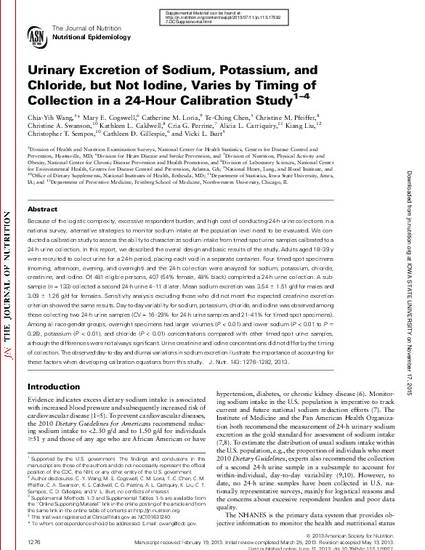
Because of the logistic complexity, excessive respondent burden, and high cost of conducting 24-h urine collections in a national survey, alternative strategies to monitor sodium intake at the population level need to be evaluated. We conducted a calibration study to assess the ability to characterize sodium intake from timed-spot urine samples calibrated to a 24-h urine collection. In this report, we described the overall design and basic results of the study. Adults aged 18–39 y were recruited to collect urine for a 24-h period, placing each void in a separate container. Four timed-spot specimens (morning, afternoon, evening, and overnight) and the 24-h collection were analyzed for sodium, potassium, chloride, creatinine, and iodine. Of 481 eligible persons, 407 (54% female, 48% black) completed a 24-h urine collection. A subsample (n = 133) collected a second 24-h urine 4–11 d later. Mean sodium excretion was 3.54 6 1.51 g/d for males and 3.09 6 1.26 g/d for females. Sensitivity analysis excluding those who did not meet the expected creatinine excretion criterion showed the same results. Day-to-day variability for sodium, potassium, chloride, and iodine was observed among those collecting two 24-h urine samples (CV = 16–29% for 24-h urine samples and 21–41% for timed-spot specimens). Among all race-gender groups, overnight specimens had larger volumes (P < 0.01) and lower sodium (P < 0.01 to P 5 0.26), potassium (P < 0.01), and chloride (P < 0.01) concentrations compared with other timed-spot urine samples, although the differences were not always significant. Urine creatinine and iodine concentrations did not differ by the timing of collection. The observed day-to-day and diurnal variations in sodium excretion illustrate the importance of accounting for these factors when developing calibration equations from this study.
Available at: http://works.bepress.com/alicia_carriquiry/33/

This article is from Journal of Nutrition 143 (2013): 1276, doi: 10.3945/jn.113.175927.